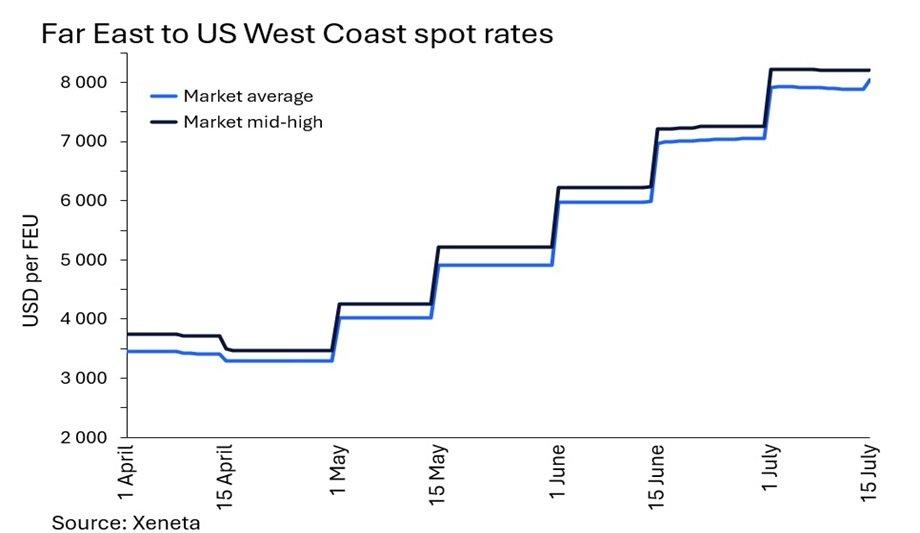The dramatic spike in the ocean freight container shipping market is reaching its peak as importers push back against spiralling spot rates.
Data released by Xeneta shows average spot rates from the Far East to the US East Coast increased by 3.7% on 15 July to stand at USD 10 045 per FEU (40ft equivalent shipping container).
Average spot rates
On the US West Coast, spot rates increased by 2.0% to stand at USD 8,045 per FEU.
While this means spot rates are up almost 150% on these trades since the end of April, the latest increases of 3.7% and 2.0% are far smaller compared to 1 July when rates rose by 22% into the US East Coast and 12% into the US West Coast.
Available capacity
Emily Stausbøll, Xeneta Senior Shipping Analyst, said, “Xeneta data shows some ocean container carriers are still pushing spot rate increases in mid-July, but, for the first time in a long time, some carriers are offering lower spot rates."
“Crucially, this suggests a growing level of available capacity in the market and shippers can once again start to play carriers off against each other - instead of feeling they need to pay whatever price they are offered to secure space. As the balance of negotiating power starts to swing back towards shippers, we should see spot rates start to come back down.”
Mid-high (and high) spot rates
Mid-high data identifies the spot rates being paid by shippers in the 75th percentile of the market
The clearest indication of a peak being reached is found in the Xeneta market ‘mid-high’ data, which identifies the spot rates being paid by shippers in the 75th percentile of the market.
On the trades from the Far East into the US, the market mid-high (and high) spot rates have remained almost flat during July, indicating the high end of the market is no longer spiralling.
Lowering prices for spots
Stausbøll said, “A flat market mid-high means a growing number of shippers and freight forwarders no longer feel they need to pay spot rates at the upper end of the market to ensure their containers are transported."
“This is the first crack in the dam because it means carriers are no longer dictating which containers to load – but rather having to lower rates to secure volumes. If these carriers want to compete and retain market share, then they need to lower their prices.”
Peak market prices
The market is reaching a peak on front haul trades from the Far East to North Europe and the Mediterranean
The market is also reaching a peak on front haul trades from the Far East to North Europe and the Mediterranean where average spot rates increased by 4.7% and 3.5% on 15 July to stand at USD 8 480 per FEU and USD 8 150 per FEU respectively. This is less than the increases of 17% and 10% on 1 July.
Stausbøll said, “It has been a painful time for shippers who have been forced to pay spiralling spot rates and faced the prospect of being unable to ship their cargo on existing long-term contracts. Signs of the spot market reaching a peak will be welcomed by shippers, but it does not mean an end to their troubles."
Port congestion
“Port congestion is easing, more ocean container shipping capacity is becoming available, and it looks likely the frontloading of imports seen earlier this year will mean a slacker traditional Q3 peak season than there would have otherwise been."
“However, spot rates remain up by just under 400% from the Far East into the US West Coast since mid-December 2023, by more than 300% into the US East Coast and 455% into North Europe. Perhaps the market has reached a peak, but shippers are still paying hugely elevated costs."
Cause of the market spike
“The fundamental cause of the market spike in 2024 is the conflict in the Red Sea, with the majority of container ships continuing to sail around the Cape of Good Hope. Unless there is a large-scale return of container ships to the Suez Canal – which seems unlikely at present - then the situation cannot be fully resolved."
“However, as we saw during March and April, the spot market can soften while the Red Sea diversions are in place, and this is what shippers will be hoping for in the remainder of 2024.”











